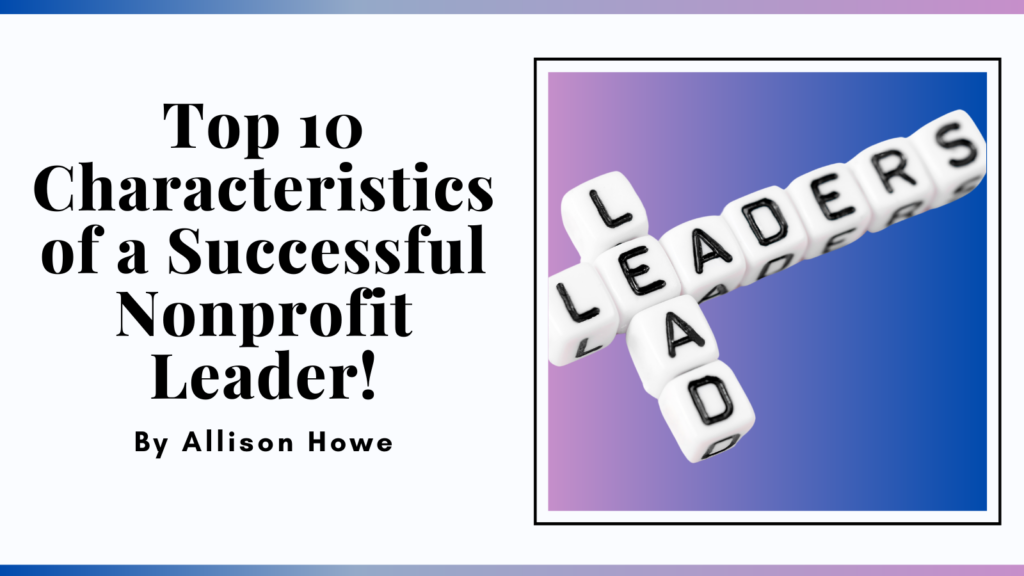
Top 10 Characteristics of a Successful Nonprofit Leader
I recently had the pleasure of being invited to speak to a Rutgers Nonprofit Management class thanks to an invitation from Dr. Josie Faass, Executive Director, Robert Schalkenbach. She asked me to share with the students what being a nonprofit leader entails from a practical perspective. It gave me a chance to reflect on my experience as an Executive Director (ED) and to think about the key to being successful in our field.
1. Flexibility: Yes, this is important in all organizations but due to nonprofits’ ongoing challenge with limited resources, ED’s really need to be able to change direction as needed to take advantage of opportunities. If you are in a smaller organization, it will likely be easier to be agile. Examples: 1) a new grant comes up that matches your needs when you were working on something else, 2) the needs of your constituents suddenly become urgent -think COVID but also a flood in the community or trees destroyed by disease (challenge borrowed from Sourland Conservancy), 3) you are having your annual event and your only employee needs root canal- guess who is making name tags? (actual event at NonProfitConnect).
2. Resourcefulness: You are constantly working with limited resources (did I mention limited resources). sometimes we in the nonprofit world get frustrated because people in the corporate world feel like they are so much more able to operate efficiently but we are able to do it on a shoestring and do whatever it is we need to do to be successful – so bring that creativity! Example: I did not actively use social media before this job but am now fairly good at it – I did not have a choice since marketing is so key to this job!
3. Not afraid to ask for help: You may need donations, volunteers, or office supplies. But you will not get them if you do not ask! Example: The second I identify that someone has a skill, I figure out how to activate them- oh, you know how to take photos, would you be willing to take photos at our program?
4. Enjoy and be good at multi-tasking: This is especially key for small nonprofits but truly does occur at every nonprofit. Example: When I was ED at the Alzheimer’s Association, I was taking Helpline calls, writing grants, handling finances/budget, strategic planning, speaking to groups about Alzheimer’s disease etc.
5. Able to manage up and down: The unique structure of a nonprofit requires you to answer to a board of people who are not all experts in nonprofits or even your field- so you need to educate them and engage them. The relationship between the ED and Board, and especially the Board Chair can make or break the success of the organization. At same time, you are managing your team.

Allison Howe, Executive Director of NonProfitConnect (front of room), introducing a topic to Leading From Within participants.
6. Ok with being Lonely at the Top: I will say that this depends on whether your nonprofit is part of a national organization – ie at Planned Parenthood and the Alzheimer’s Association, there were scheduled national conferences to bring peer ED’s together. But most nonprofit ED’s do not have obvious peers – there may be other peers doing similar work but they are also competing for staff/grants so there may be barriers.
7. Scrappy/Go-getter: If you are a nonprofit ED in Mercer County, you are competing with 2400 other nonprofits for funds, attention, board members etc. You have to be willing to get put yourself out in the world and actively engage to get what your nonprofit needs.
8. Willing to do whatever it takes (task): Again, this is especially true for smaller nonprofits. Example: I was ED for the Alzheimer’s Association—I painted the donated office space. I got up at 4:30am to host the annual Atlantic City Memory Walk and then of course, I was at the microphone welcoming everyone!
9. Passionate about your cause: Your job is to bring people into your work and to get them to volunteer and donate money. If you are not passionate, no one else is going to be! Also, how are you going to stay committed in those late night hours if you don’t care about what you are doing?
10. Know when to say “No”: Nonprofit leaders tend to naturally want to help their community, solve all the problems and do all the things! But, we are human and truly can not do everything. Prioritizing time and work/life balance are essential to avoid the burnout that faces 30% of nonprofit employees.
I really love being an ED – I relish the challenges, the personal rewards of the work and the amazing people I meet along the way. For anyone considering this position, know that you will join a special group of committed people whose work makes a difference every day. But it is not for the faint of heart!
